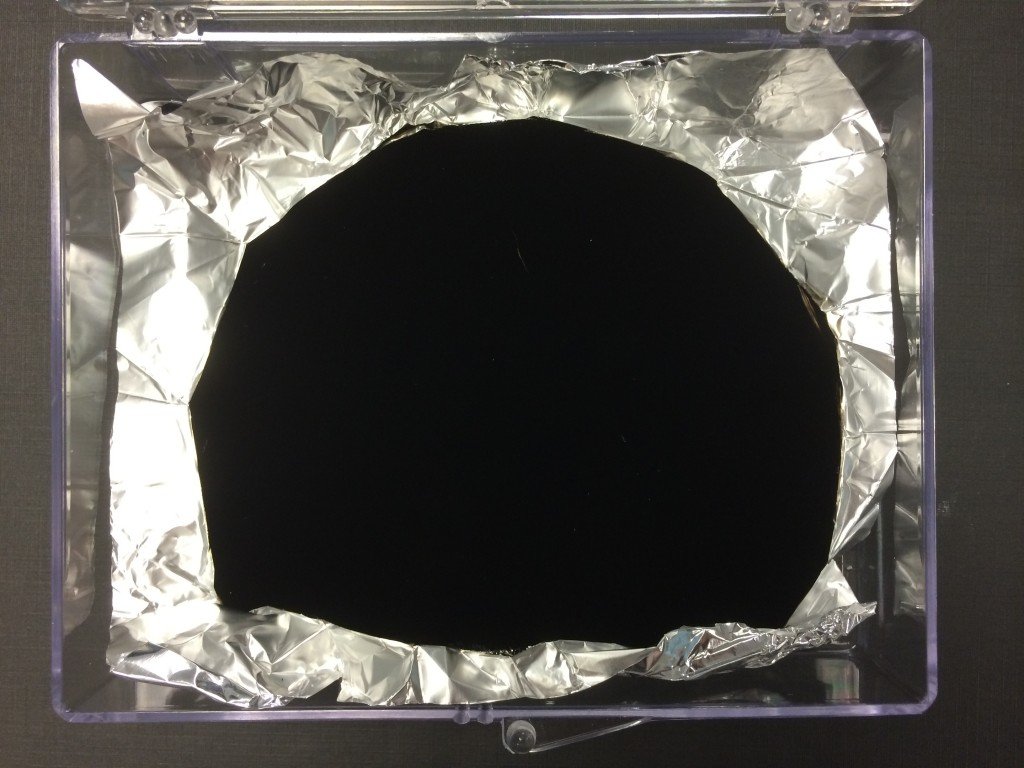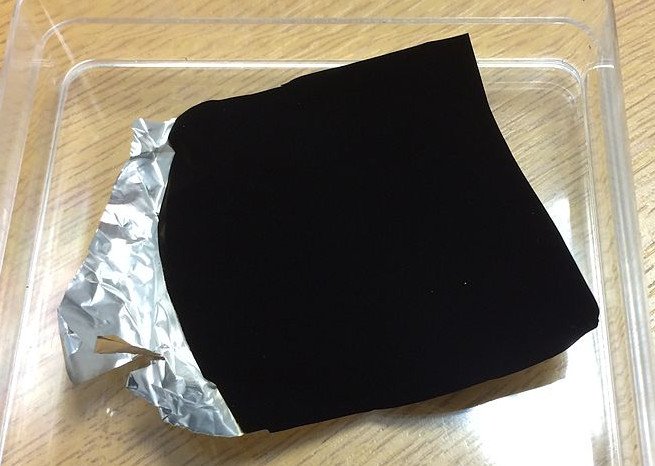Table of Contents (click to expand)
Vantablack is a super black coating that is the darkest substance man has ever synthesized. It is made of densely packed carbon nanotubes that are aligned vertically along each other, and it absorbs almost 99.99% of light. It was originally developed for satellites to soak up the Sun’s shower of light to the last drop, but it has many other potential uses.
Vantablack retains 99.965% of the light that falls on its ensnaring surface, making it appear as though a wormhole to a remote corner in deep space.
The color black reminds me of Woody Allen’s thick rimmed glasses or Diane Keaton’s bulging hats. However, even Woody Allen’s glasses gleam with the Sun’s light when he pensively walks the streets of New York City. Perhaps even darker are the letters that are conjured on my screen as I type, but even darker is the tiny square on my keyboard that transforms an ‘O’ to a ‘C’. This bit is the difference between a dreary bowl of oats and a troupe of surreptitious cats.
Black cats were one group amongst the several that dwelled in Edgar Allen Poe’s infamous menagerie. Another was the macabre raven. Perhaps, an even darker example is the cover of my father’s Bible or my Being and Nothingness by Sartre. But the darkest of them all are the black holes limned by Stephen Hawking in his A Brief History of Time; even something as elusive as light cannot escape a black hole’s sinister pull.

To witness this stellar phenomenon in the past, you would need to travel billions of miles away, but not anymore — the British company Surrey NanoSystems has created a material that is the closest thing to a black hole that we’ll ever ‘see’. The super black coating is the darkest substance man has ever synthesized – it’s called Vantablack.
Vantablack
Vantablack, which sounds like a Marvel character, is actually an acronym for Vertically Aligned Nano Tube Arrays-black. Color is not a property of nature, but rather an invention of the mind. The plethora of colors that we find around us are a result of wavelengths stimulating special receptors in our eyes known as rods. However, amongst the different bands that constitute the electromagnetic spectrum, our rods only respond to a few of them. We call this the visible range.

If colors are just the absorption and reflection of wavelengths, black and white aren’t colors, but rather a representation of absolute absorption and reflection, respectively. An object appears black because it has absorbed all the wavelengths of light incident on it, whereas, an object appears white because, on the contrary, it has reflected all incident wavelengths.
Vantablack is so dark that it allows almost no incident light to reflect and escape. The National Physical Laboratory in Teddington found that it retains 99.965% of the light that falls on its ensnaring surface — it reflects just 0.035% of incident light. That is phenomenal!

Like your friend who promises to have just a ‘single’ bite, vantablack doesn’t just absorb wavelengths that correspond to visible light, it presumptuously consumes wavelengths adjacent to it as well — its prodigious retention also absorbs ultraviolet and infrared wavelengths, wavelengths that our eyes can’t even perceive! However, what makes it so powerful in this respect?
Also Read: How Can Some Objects Be Completely Black And Still Be Highly Reflective?
A ‘Forest’ Of Nanotubes
The material Vantablack is composed of densely packed carbon nanotubes that are aligned vertically along each other. Surrey NanoSystems describe this arrangement as a forest populated by millions of soaring trees. Each tube is around 20 nanometers wide and 14-20 nanometers tall, making it 3,500 times smaller than a human hair. The tubes are so compact that a square of 1 cm x 1 cm bounds at least 1 billion of them!
When light enters this dense forest, the space between the tubes brusquely absorbs the light as it reflects and ricochets off them. The light is unable to escape because the tubes are quite tall with respect to their diameter and the space between them. For instance, if the trees populating a forest were 2-3 km long, light penetrating the forest from above would find it almost impossible to reach the surface below.

Ironically, the carbon nanotubes are “grown” by subjecting them to light; lamps that burn at 430º C.
Also Read: What Is Dark Matter And How Do We Know It Exists?
Vantablack Applications
Due to its unique physical properties, light incident on a coating of Vantablack is converted to heat. Given that it absorbs almost 99.99% of light, the conversion of energy is huge. It is this penchant for absorption and heat that led Vantablack to be originally developed for satellites to soak up the Sun’s shower of light to the last drop. The heat can then be used to, say, power electronics or heat water on a spacecraft.
Its high absorption also ensures the reduction of unwanted stray light around high-performance infrared cameras, sensors and various scientific instruments. To gauge its durability or robustness to guarantee its efficacy in such complex environments, researchers rigorously tested it for elasticity, heat resistance, shock resistance and vibration. These attributes could revolutionize space and defense technologies, whether through electro-optical imaging or target acquisition systems.

Its hypnotizing black color is also utilized by designers and artists to adorn objects and contrive inexplicable optical illusions. In fact, the lack of shades makes even a thick, three-dimensional coating appear two-dimensional. A circular sheet looks like a wormhole to a remote corner of deep space. If you were to reside in a room wallpapered with Vantablack, you would lose your sense of space and time. The beguiling darkness would beckon you to gaze into it, and “when you gaze long into the abyss, the abyss also gazes into you.”
How well do you understand the article above!

